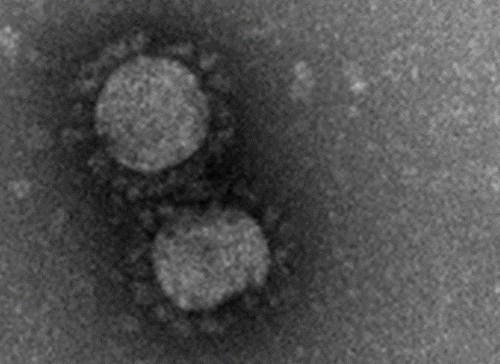Middle East respiratory syndrome-related coronavirus (MERS-CoV) batch release

Transmission Electron Microscope Image of NCPV 1409231v MERS Coronavirus. Image supplied by Microbial Imaging, UKHSA Porton.
The NCPV team is delighted to announce that a new batch of Middle East respiratory syndrome-related coronavirus (MERS-CoV; NCPV 1409231v) has been made available in the NCPV catalogue.
The NCPV team is delighted to announce that a new batch of Middle East respiratory syndrome-related coronavirus (MERS-CoV; NCPV 1409231v) has been made available in the NCPV catalogue. MERS-CoV was the second coronavirus to cause a serious outbreak of disease in humans, occurring in 2012 (1, 2). The first outbreak was caused by severe acute respiratory syndrome-related coronavirus (SARS-CoV) in 2003 (3, 4). The global SARS-CoV-2 pandemic, like infectious disease outbreaks of the past, has demonstrated the value of retaining stocks of viruses which could be of value for the research and diagnostics of emerging disease.
Below we highlight two papers (by Napolitano et al. and Milewska et al.) that have used NCPV’s MERS-CoV for pandemic response work.
In tandem with the protective effect of vaccines, antivirals are advantageous in treating COVID-19. Pre-existing drugs are valuable resource given the lengthy approvals process for new antivirals. After initial candidates lopinavir–ritonavir (5) and hydroxychloroquine (6) showed no beneficial treatment, Napolitano et al. (7) showed in their recent 2022 publication that acriflavine, a disinfectant and topical antiseptic, inhibits various betacoronaviruses in vitro, ex vivo, and in vivo. Acriflavine is a mixture of trypaflavine and proflavine, similar compounds with a difference of one methyl group. The proflavine constituent was shown to inhibit substrate access to the viral papain-like protease (PLpro), an enzyme essential to SARS-CoV-2 replication. The role of PLpro, and main protease (Mpro), is to fragment polyproteins (i.e. the translated virus genome) into smaller pieces that are then processed into individual proteins. When PLpro is inhibited, so too is betacoronavirus replication. An in vivo pharmacokinetic experiment on a mouse lung model suggests that an approved dosage of acriflavine reaches therapeutic levels to inhibit SARS-CoV-2, HCoV-OC43, and MERS-CoV growth.
A different molecule, HTCC (N-(2-hydroxypropyl)-3-trimethylammonium chitosan chloride), was presented by Milewska et al. in 2021 (8) as inhibiting MERS-CoV and SARS-CoV-2 infection. This molecule has previously been shown to inhibit the low-pathogenicity HCoV-NL63, HCoV-229E, HCoV-OC43, and HCoV-HKU1, suggesting that HTCC has a broad range of activity against both betacoronaviruses and alphacoronaviruses. In vitro, MERS-CoV replication was inhibited 2-to-3-fold, and SARS-CoV-2 replication was inhibited approximately 10,000 fold. The reason for this reduction appears to be HTCC’s interaction with the Spike protein, shown by comparing a vesicular stomatitis virus control against a lentiviral vector pseudotyped with Spike. These were propagated in A549ACE2+ cells; once harvested, quantification showed a significant reduction in pseudotyped lentivirus compared to the VSV control.
We are delighted that our MERS-CoV (NCPV 1409231v) has contributed to these studies and we hope its continued supply will go on to support further research. We also have a number of other coronaviruses available.
Written by Jane Burton and Ellie Drinkwater
References:
1. Public Health England. (2018). MERS-CoV: clinical management and guidance, UK Government, https://www.gov.uk/government/collections/middle-east-respiratory-syndrome-coronavirus-mers-cov-clinical-management-and-guidance#full-publication-update-history
2. Middle East respiratory syndrome coronavirus (MERS-CoV). (2019, March 11). World Health Organisation, https://www.who.int/news-room/fact-sheets/detail/middle-east-respiratory-syndrome-coronavirus-(mers-cov)
3. 2003 – China: Disease Outbreak Reported (2003, March 12). World Health Organisation, https://www.who.int/emergencies/disease-outbreak-news/item/2003_03_12-en
4. 2003 – China: Disease Outbreak Reported (2003, March 17). World Health Organisation, https://www.who.int/emergencies/disease-outbreak-news/item/2003_03_17-en
5 Cao, B., Wang, Y., Wen, D., Liu, W., Wang, J., Fan, G., ... & Wang, C. (2020). A trial of lopinavir–ritonavir in adults hospitalized with severe Covid-19. New England Journal of Medicine.
6. RECOVERY Collaborative Group. (2020). Effect of hydroxychloroquine in hospitalized patients with Covid-19. New England Journal of Medicine, 383(21), 2030-2040.
7. Napolitano, V., Dabrowska, A., Schorpp, K., Mourão, A., Barreto-Duran, E., Benedyk, M., ... & Pyrc, K. (2022). Acriflavine, a clinically approved drug, inhibits SARS-CoV-2 and other betacoronaviruses. Cell chemical biology.
8. Milewska, A., Chi, Y., Szczepanski, A., Barreto-Duran, E., Dabrowska, A., Botwina, P., ... & Pyrc, K. (2021). HTCC as a Polymeric Inhibitor of SARS-CoV-2 and MERS-CoV. Journal of Virology, 95(4), e01622-20.
